Conferences and debates
Index / Activities / Conferences and debates / Earthen architecture in Morocco: Preserving a rich heritage
Earthen architecture in Morocco: Preserving a rich heritage
October 04, 20177:00 p.m.
Casa Árabe Auditorium (at Calle Alcalá, 62)
7:00 p.m.
Free entry until the event’s capacity is reached.
In Spanish.
Among the activities being held during Architecture Week, Casa Árabe and
the Terrachidia Association have organized this conference.
This conference will include the participation of Faissal Cherradi Akbil, an architect and specialist in Morocco’s earthen architecture and its restoration, as well as being an advisor for the Ministry of Culture and Communication of the Kingdom of Morocco, and Carmen Moreno Adán, an architect with expertise in restoring heritage and a member of the development NGO Terrachidia.
This round table discussion has been organized on the occasion of the official opening of the exhibition “M’hamid, the Last Oasis in the Drâa Valley,” presented by Casa Árabe as part of Architecture Week. The idea is to let visitors get a closer look at the oasis of M’hamid, showing them its territory and the local form of architecture, which is characterized by the use of earth as a construction material, giving the landscape in southern Morocco special value as a heritage site, the preservation of which must be promoted. M’hamid is a place where traditions remain alive, earthen construction remains the norm and the local population, organized into associations for the region’s development, has been involved in the Terrachidia project from the very beginning, increasing their involvement and enthusiasm throughout the five years in which the project has been carried out.
This round table discussion has been organized on the occasion of the official opening of the exhibition “M’hamid, the Last Oasis in the Drâa Valley,” presented by Casa Árabe as part of Architecture Week. The idea is to let visitors get a closer look at the oasis of M’hamid, showing them its territory and the local form of architecture, which is characterized by the use of earth as a construction material, giving the landscape in southern Morocco special value as a heritage site, the preservation of which must be promoted. M’hamid is a place where traditions remain alive, earthen construction remains the norm and the local population, organized into associations for the region’s development, has been involved in the Terrachidia project from the very beginning, increasing their involvement and enthusiasm throughout the five years in which the project has been carried out.
Faissal Cherradi Akbil (Tangiers, Morocco, 1963)
Educated to become an architect at the Universities of Granada and Normandy, in 1994 he was named director of the Center for Restoration of the Southern Kasbahs in Ouarzazate, Morocco, where he worked for five years on the earthen architecture in the south of the country, on projects for restoration, inventories, assessment, etc. After that, he held the position of regional director of Culture in Marrakesh and was an inspector of historical monuments up to 2007, carrying out important restoration projects on major monuments in the region and reconstruction projects in the medina. He held a similar position, as well, for four years in the region of Casablanca, with projects focusing on reconstruction in the medina and the city’s twentieth-century architectural heritage. At present, he is responsible for projects and an advisor for the Ministry of Culture and Communication of the Kingdom of Morocco.
Carmen Moreno Adán
An architect with a Master’s degree in Architectural Heritage Preservation and Restoration, Moreno Adán is a specialist in Human Settlements in Developing Countries with a degree from the Universidad Politécnica de Madrid. She has been a guest conference speaker at many congresses and devotes her professional activity to recovering public spaces in traditional cities, as well as restoring and reconstructing historical buildings. In addition to her work in Morocco, she has carried out various interventions in Madrid’s historical center and different rural areas in Spain, the most notable of which highlight traditional architecture and materials.
Educated to become an architect at the Universities of Granada and Normandy, in 1994 he was named director of the Center for Restoration of the Southern Kasbahs in Ouarzazate, Morocco, where he worked for five years on the earthen architecture in the south of the country, on projects for restoration, inventories, assessment, etc. After that, he held the position of regional director of Culture in Marrakesh and was an inspector of historical monuments up to 2007, carrying out important restoration projects on major monuments in the region and reconstruction projects in the medina. He held a similar position, as well, for four years in the region of Casablanca, with projects focusing on reconstruction in the medina and the city’s twentieth-century architectural heritage. At present, he is responsible for projects and an advisor for the Ministry of Culture and Communication of the Kingdom of Morocco.
Carmen Moreno Adán
An architect with a Master’s degree in Architectural Heritage Preservation and Restoration, Moreno Adán is a specialist in Human Settlements in Developing Countries with a degree from the Universidad Politécnica de Madrid. She has been a guest conference speaker at many congresses and devotes her professional activity to recovering public spaces in traditional cities, as well as restoring and reconstructing historical buildings. In addition to her work in Morocco, she has carried out various interventions in Madrid’s historical center and different rural areas in Spain, the most notable of which highlight traditional architecture and materials.



